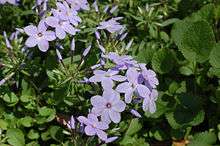Phlox stolonifera
Phlox stolonifera (creeping phlox or moss phlox) is an herbaceous, stoloniferous, perennial, plant that is native to woodlands in the vicinity of the Appalachian Mountains from Pennsylvania south to northern Georgia in the United States. Naturalized populations occur as far north as Québec, Canada.[1]
| Phlox stolonifera | |
|---|---|
 | |
| Scientific classification | |
| Kingdom: | Plantae |
| Clade: | Tracheophytes |
| Clade: | Angiosperms |
| Clade: | Eudicots |
| Clade: | Asterids |
| Order: | Ericales |
| Family: | Polemoniaceae |
| Genus: | Phlox |
| Species: | P. stolonifera |
| Binomial name | |
| Phlox stolonifera Sims 1802 | |
Its flowers are pale purple, pink, or white; 2–2.5 cm (0.79–0.98 in) in diameter; with a five-lobed corolla and yellow stamens; and borne on stems that are 15–25 cm (6–10 in) tall. They lack the central band of color that is present in the flowers of Phlox subulata.[2]
The leaves are ovate. Those on creeping stems are 3–4.5 cm (1.2–1.8 in) long and 1.8 cm (0.71 in) broad, and those on the erect flowering stems are smaller, 2 cm (1 in) long.[2]
Gallery
 Large patch of phlox
Large patch of phlox Creeping stems at edge of patch
Creeping stems at edge of patch
gollark: You were talking about parsing regex with JSON.
gollark: You wrote #2, didn't you?
gollark: Since I wrote #4, which is the case.
gollark: Wow, the syntax highlighter really worked badly on my submission.
gollark: TOTALLY not mine.
References
- Biota of North America Program 2014 county distribution map
- Sims, John. 1802. Curtis's botanical magazine, plate 563 and preceding unnumbered textual page full-page color illustration, description, and commentary.
External links
| Wikimedia Commons has media related to Phlox stolonifera. |
- Discover Life, University of Georgia (includes distribution map)
- North Carolina State University
This article is issued from Wikipedia. The text is licensed under Creative Commons - Attribution - Sharealike. Additional terms may apply for the media files.